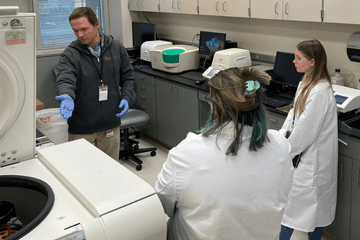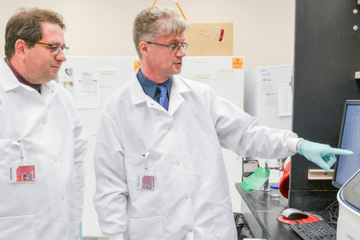March is National Bleeding Disorder Awareness Month, an annual movement meant to raise awareness, provide support for individuals and families affected by bleeding disorders, and to advocate for better care and treatment for those living with these conditions. According to the U.S. Centers for Disease Control (CDC), about three million people in the United States are affected by bleeding disorders, including hemophilia A and B.
At the Herman B Wells Center for Pediatric Research at the Indiana University School of Medicine there is a research program that incorporates the spirit of Bleeding Disorder Awareness Month into its work every day--not just in March. The Gene and Cell Therapy program is dedicated to advancing gene and immunotherapy research for hemophilia and other genetic disorders.

“The Gene Therapy field has come a long way since the 1980s when the genes encoding blood coagulation factors IX and VIII were cloned, but the ultimate cures we have been awaiting are still unmet,” said Radek Kaczmarek, PhD, MSC, assistant research professor of pediatrics and member of the Gene and Cell Therapy program who also happens to be a hemophilia A patient.
“There are multiple unknowns around the safety and efficacy of current gene therapies pointing to major gaps in our fundamental biological understanding of gene transfer in humans. Our Gene and Cell Therapy program has a unique combination of expertise, drive and legacy, and thus is uniquely well-placed to address these unanswered questions, and inform development of even better treatments and actual cures.”
Riley Children's Foundation Professor of Immunology Roland Herzog, PhD, leads the Gene and Cell Therapy program which was established at the Wells Center in 2018 and is now comprised of four principal investigators, four research faculty members, and 14 students, trainees and staff. The Gene and Cell Therapy group has made instrumental achievements in hemophilia research, and their impact extends far beyond the last five years.
Herzog and his Wells Center colleague, Weidong Xiao, PhD, professor of pediatrics, met in the late 1990s while they both served as assistant professors of pediatrics at the University of Pennsylvania. In 2002, Herzog and Xiao were among the first to study the effectiveness of the adeno-associated viral vector called serotype 5 (AAV5) as useful for liver gene transfer. They published a paper in Journal of Virology about their research, and found AAV5 could be even more effective than the commonly used serotype 2 (AAV2) in delivering the protein called coagulation factor IX (FIX) to liver cells, which helps the blood form clots to stop bleeding.
“At the time, we just tried everything we could to figure out what might work,” Herzog said. “Our studies in animal models showed AAV5 transferred the factor IX better than AAV2 in the liver. We believed it might be a promising candidate for gene therapies in humans. And sure enough, more than twenty years later, the first gene therapy drug for hemophilia B has obtained regulatory approval in the US using the same concepts we uncovered in 2002.”

The Food and Drug Administration’s (FDA) approval of Hemgenix, the gene therapy product owned by CSL Behring, is a milestone two decades in the making for Xiao and Herzog, and they look forward to the impact of similar discoveries for future patients and treatments.
“Hemgenix is currently only available to adults, and is very expensive,” Herzog said. “But there are many studies and groups like ours working hard to get more therapies out into the public and to help future generations with safer treatment options.”
Last year, the Gene and Cell Therapy program received a prestigious $12 million award from the National Heart, Lung and Blood Institute (NHLBI) to fund basic and translational studies that could lead to safer hemophilia treatments. The group and their research partners provide regular updates and information about the grant’s ongoing efforts related to the “Toward Safer Gene Therapy for Hemophilia A” project on their website.
Those interested in learning more can visit: medicine.iu.edu/research-centers/pediatrics/research/gene-cell-therapy/p01-grant